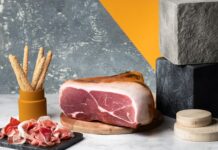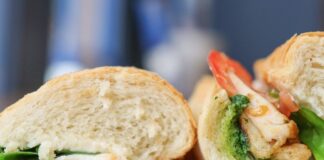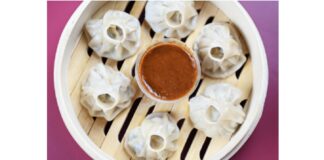
As Thanksgiving approaches, the question that should be arising for home cooks is not whether to brine the turkey, but which brine to use. Brining — soaking the bird in salted water for many hours — eliminates the age-old problem of dried-out white meat vs. undercooked legs and thighs. During the brining process, the turkey “drinks in” some of the water, while the salt dissolves some muscle proteins. As a result, the meat contracts less while it’s in the oven and loses less moisture as it cooks.
Which brine you chose is a matter of preference since the bird will pick up the flavoring agents added to the brine, lending it new flavor dimensions.
Here are two brine options conceived by Catherine McCord, model turned Food Network judge, blogger, and cookbook author. More about each recipe and additional tips can be found at McCord’s blog weelicious.
Note that the recipes are identical from Step 3 on. The steps are repeated for ease of use by readers.
Maple Brined Turkey
Ingredients
- 12 to 14 pound whole turkey, defrosted
- 1 cup maple syrup
- 1 cup kosher salt
- 1 orange, cut in half
- 1 onion, quartered
- 10 cloves
- 20 peppercorns
- 3 star anise
- 1 to 2 Tbsp. vegetable or canola oil
Directions
- Add the sugar and salt to 4 cups of hot water. Stir until dissolved.
- Transfer the maple syrup mixture to a container large enough to hold the turkey. (A large stock pot may be used for this purpose.) Add a gallon of cold water, the juice of the orange, the orange halves (once juiced, of course), the onion, cloves, peppercorns, and star anise, and stir to combine.
- Wash the turkey inside and out (putting aside the neck and liver to make gravy) and place breast side down in the container with the brine. The brine should just cover the turkey.
- Refrigerate 18 hours to 2 days.
- Preheat oven to 450 degrees F.
- Remove turkey from brine and rinse inside and out with cold water. Discard the brine.
- Place the turkey on a roasting rack inside a wide low roasting pan and blot with paper towels.
- Tuck back the wings (this prevents them from burning) and rub the skin of the turkey with the oil.
- Roast on the lowest rack of the oven for 30 minutes and then place a piece of foil just over the breast of the turkey to cover. (The breast cooks faster then the legs and wings so this process helps it to cook more evenly).
- Add 1 cup of water to the pan. Reduce temperature to 350 and continue to roast 1 hour.
- Remove the foil from the breast, turn the pan so the other side of the breast is towards the back of the oven (most oven’s heat comes from the back, so turning it prevents overcooking), and cook for another hour to 90 minutes.
- Insert a meat thermometer into the deepest part of the thigh (avoiding the bone) until you reach a temperature of 160 to 165 degrees. (The turkey will actually continue to cook a bit more even after you remove it from the oven.)
- Let the turkey rest for 20 to 30 minutes to allow the juices to redistribute and settle.
- Slice and serve.
Yield: 12 servings
“Best” Brined Turkey
Ingredients
- 1 cup sugar
- 1 cup kosher salt
- 12 to 14 pound whole turkey, defrosted
- 4 cloves
- 4 bay leaves
- 1 Tbsp. vegetable or canola oil
Directions
- Add the sugar and salt to 4 cups of hot water. Stir until dissolved.
- Place the brine into a container large enough to hold the turkey. (A large stock pot may be used for this purpose.) Add a gallon of cold water, cloves, and bay leaves. Stir to combine.
- Wash the turkey inside and out (putting aside the neck and liver to make gravy) and place breast side down in the container with the brine. The brine should just cover the turkey.
- Refrigerate 18 hours to 2 days.
- Preheat oven to 450 degrees F.
- Remove turkey from brine and rinse inside and out with cold water. Discard the brine.
- Place the turkey on a roasting rack inside a wide low roasting pan and blot with paper towels.
- Tuck back the wings (this prevents them from burning) and rub the skin of the turkey with the oil.
- Roast on the lowest rack of the oven for 30 minutes and then place a piece of foil just over the breast of the turkey to cover. (The breast cooks faster then the legs and wings so this process helps it to cook more evenly).
- Add 1 cup of water to the pan. Reduce temperature to 350 and continue to roast 1 hour.
- Remove the foil from the breast, turn the pan so the other side of the breast is towards the back of the oven (most oven’s heat comes from the back, so turning it prevents overcooking), and cook for another hour to 90 minutes.
- Insert a meat thermometer into the deepest part of the thigh (avoiding the bone) until you reach a temperature of 160 to 165 degrees. (The turkey will actually continue to cook a bit more even after you remove it from the oven.)
- Let the turkey rest for 20 to 30 minutes to allow the juices to redistribute and settle.
- Slice and serve.
Yield: 12 servings














